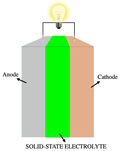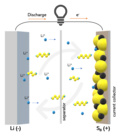Lithium metal batteries are primary batteries that have metallic lithium as an anode. The name intentionally refers to the metal as to distinguish them...
51 KB (4,349 words) - 20:46, 30 September 2024
conventional batteries. Solid-state batteries theoretically offer much higher energy density than the typical lithium-ion or lithium polymer batteries. While...
89 KB (9,438 words) - 10:31, 21 November 2024
A lithium polymer battery, or more correctly, lithium-ion polymer battery (abbreviated as LiPo, LIP, Li-poly, lithium-poly, and others), is a rechargeable...
26 KB (2,932 words) - 08:36, 31 July 2024
A lithium-ion or Li-ion battery is a type of rechargeable battery that uses the reversible intercalation of Li+ ions into electronically conducting solids...
205 KB (21,729 words) - 13:52, 11 November 2024
up lithium battery in Wiktionary, the free dictionary. Lithium battery may refer to: Lithium metal battery, a non-rechargeable battery with lithium as...
1 KB (217 words) - 17:29, 19 April 2024
The lithium–air battery (Li–air) is a metal–air electrochemical cell or battery chemistry that uses oxidation of lithium at the anode and reduction of...
50 KB (5,671 words) - 09:58, 17 November 2024
lithium–sulfur battery (Li–S battery) is a type of rechargeable battery. It is notable for its high specific energy. The low atomic weight of lithium...
59 KB (5,672 words) - 22:07, 17 October 2024
as electrolytes for high-energy rechargeable lithium metal batteries was demonstrated. Thermal batteries originated during World War II when German scientist...
32 KB (3,869 words) - 03:50, 15 July 2024
Rechargeable lithium metal batteries are secondary lithium metal batteries. They have metallic lithium as a negative electrode. The high specific capacity...
11 KB (1,241 words) - 12:59, 22 August 2024
ceramics, lithium grease lubricants, flux additives for iron, steel and aluminium production, lithium metal batteries, and lithium-ion batteries. These uses...
141 KB (13,770 words) - 00:30, 22 November 2024
reported a charge-discharge cycling with a lithium metal battery (a precursor to modern lithium-ion batteries) in the 1970s. Drawing on previous research...
54 KB (5,926 words) - 15:02, 11 November 2024
A nickel–metal hydride battery (NiMH or Ni–MH) is a type of rechargeable battery. The chemical reaction at the positive electrode is similar to that of...
37 KB (3,993 words) - 03:50, 18 November 2024
Lithium nickel manganese cobalt oxides (abbreviated NMC, Li-NMC, LNMC, or NCM) are mixed metal oxides of lithium, nickel, manganese and cobalt with the...
23 KB (2,478 words) - 14:12, 9 November 2024
Archived from the original on 2019-07-31. Retrieved 2019-02-26. "New lithium batteries last longer and don't burst into flames". 17 August 2018. "CeraCharge™...
6 KB (203 words) - 14:28, 4 November 2024
nickel–metal hydride (NiMH), lithium-ion (Li-ion), lithium iron phosphate (LiFePO4), and lithium-ion polymer (Li-ion polymer). Rechargeable batteries typically...
48 KB (5,080 words) - 21:21, 3 November 2024
density of lithium metal (up to 3458 Wh/kg) inspired the design of lithium–air batteries. A lithium–air battery consists of a solid lithium electrode,...
20 KB (2,197 words) - 08:59, 22 August 2024
and cell construction are similar to those of lithium-ion battery (LIB) types, but it replaces lithium with sodium as the intercalating ion. Sodium belongs...
69 KB (7,043 words) - 18:54, 18 November 2024
(Ni-Cd), nickel metal hydride (Ni-MH), lithium-ion (Li-ion) and nickel–zinc (Ni-Zn), can also be recycled. Disposable alkaline batteries make up the vast...
53 KB (5,305 words) - 22:51, 11 November 2024
Lithium batteries are batteries that use lithium as an anode. This type of battery is also referred to as a lithium-ion battery and is most commonly used...
25 KB (2,658 words) - 15:09, 6 September 2024
rechargeable form in nickel–cadmium (Ni–Cd), nickel–metal hydride (Ni–MH) and lithium-ion. Mercury batteries of this format, once common, have been banned in...
16 KB (1,575 words) - 00:09, 4 November 2024
an AFB operates as a lithium metal battery. By eliminating the permanent lithium metal anode, AFBs operate with all the lithium acts as a charge carrier...
9 KB (1,061 words) - 15:03, 4 August 2024
attracted attention as a component of lithium iron phosphate batteries, a type of Li-ion battery. This battery chemistry is targeted for use in power...
35 KB (4,212 words) - 02:58, 11 November 2024
typically lithium-ion batteries that are designed for high power-to-weight ratio and energy density. Compared to liquid fuels, most current battery technologies...
76 KB (7,916 words) - 01:36, 14 November 2024
Research in lithium-ion batteries has produced many proposed refinements of lithium-ion batteries. Areas of research interest have focused on improving...
100 KB (11,790 words) - 20:32, 19 November 2024
Electrode (redirect from Battery electrode)
solid lead. Other commonly used rechargeable batteries are nickel–cadmium, nickel–metal hydride, and Lithium-ion. The last of which will be explained more...
42 KB (5,113 words) - 04:55, 18 November 2024
Whittingham's rechargeable lithium metal battery is based on a LiAl anode and an intercalation-type TiS2 cathode. His work on lithium batteries laid the foundation...
25 KB (2,224 words) - 04:38, 9 September 2024
The glass battery is a type of solid-state battery. It uses a glass electrolyte and lithium or sodium metal electrodes. The battery was invented by John...
13 KB (1,447 words) - 03:41, 31 July 2024
Lithium–silicon batteries are lithium-ion batteries that employ a silicon-based anode, and lithium ions as the charge carriers. Silicon based materials...
32 KB (3,563 words) - 18:47, 9 November 2024
A lithium ion manganese oxide battery (LMO) is a lithium-ion cell that uses manganese dioxide, MnO 2, as the cathode material. They function through the...
13 KB (1,479 words) - 00:55, 26 February 2024
compound has found use as a methylating agent and as a co-solvent in lithium-ion batteries. Notably, dimethyl carbonate is a weak methylating agent, and is...
14 KB (1,436 words) - 22:12, 1 February 2024





















